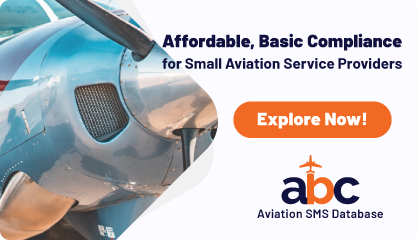Creating Training Modules From Lessons Learned

In aviation, where safety is the top priority, every incident, near-miss, or hazard provides a critical opportunity to learn and prevent future mistakes.
A lessons learned library captures these insights, but its true value lies in transforming them into actionable training modules that ensure employees—pilots, maintenance crews, ground staff, and others—learn from past errors. For aviation safety managers, creating effective training modules from documented lessons learned is a key component of a proactive Safety Management System (SMS), aligning with International Civil Aviation Organization (ICAO) standards and fostering a culture of continuous improvement.
This comprehensive, guide outlines a step-by-step process to develop training modules from lessons learned, helping safety managers reduce risks, enhance compliance, and empower employees to make safer decisions. Whether you manage an airline, airport, maintenance organization, or flight school, this evergreen article will equip you with practical strategies to turn safety data into impactful learning experiences.
Why Training Modules From Lessons Learned Are Essential
Training modules based on lessons learned bridge the gap between documented safety insights and real-world application. According to ICAO’s Safety Management Manual (Doc 9859), Safety Promotion—one of the four SMS pillars—emphasizes the importance of training and communication to maintain a robust safety culture. Well-crafted training modules:
- Prevent Recurring Incidents: By teaching employees how to avoid past mistakes, such as miscommunications or maintenance oversights.
- Enhance Compliance: Demonstrate to regulators (e.g., FAA, EASA) that your organization applies safety insights systematically.
- Strengthen Just Culture: Encourage reporting by showing employees that their contributions lead to meaningful change.
- Improve Engagement: Real-world scenarios make training relevant, increasing retention and application.
For safety managers, the challenge is to create training that is practical, engaging, and directly tied to your organization’s safety data. A lessons learned library, as outlined in prior discussions, serves as the foundation, providing a repository of incidents, root causes, and corrective actions to draw from. Let’s explore how to turn this data into effective training modules.
Related Articles on Lessons Learned Library in Aviation SMS Context
- Why Lessons Learned Library Matters for Aviation Safety
- How Mistakes Improve Aviation SMS Processes - Lessons Learned Library
- Comprehensive Guide to Using a Lessons Learned Library in Aviation SMS
Key Principles for Effective Training Modules
Before diving into the process, consider these principles to ensure your training modules are impactful:
- Relevance: Base content on real incidents or hazards specific to your operations.
- Clarity: Present lessons in a concise, actionable format.
- Engagement: Use interactive elements like scenarios or quizzes to maintain interest.
- Accessibility: Ensure modules are easy to access via mobile devices or Learning Management Systems (LMS).
- Measurability: Include assessments to verify comprehension and track performance.
With these principles in mind, follow this step-by-step guide to create training modules that drive safety improvements.
Step-by-Step Guide to Creating Training Modules From Lessons Learned

Step 1: Identify High-Impact Lessons
Start by selecting lessons from your lessons learned library that have the greatest potential to improve safety. Prioritize entries based on:
- Severity: Focus on incidents or near-misses with significant consequences (e.g., runway incursions, engine failures).
- Frequency: Address recurring issues, such as communication errors or fatigue-related hazards.
- Relevance: Choose lessons applicable to specific roles (e.g., pilots, ground handlers).
- Regulatory Alignment: Ensure alignment with ICAO, FAA, or EASA requirements.
For example, an airline might select a lesson about a 2024 taxiway collision caused by poor crew coordination, with corrective actions including revised communication protocols. Use analytics from SMS software like SMS Pro or ABC to identify trends, such as a 30% increase in ground handling errors, to guide your selection.
Step 2: Analyze Root Causes and Corrective Actions
Each training module should clearly explain the incident, its root cause, and the actions taken to prevent recurrence. Use tools like the 5 Whys, Fishbone Diagram, or Bowtie Analysis to dissect the lesson. For the taxiway collision example:
- Incident: Collision during taxi due to miscommunication.
- Root Cause: Inadequate crew resource management (CRM) training and fatigue.
- Corrective Action: Updated CRM training and mandatory rest periods.
- Outcome: 50% reduction in similar incidents over 12 months.
This analysis forms the core of the module, ensuring employees understand why the incident occurred and how to avoid it. Cross-reference with your lessons learned library to ensure accuracy and consistency.
Step 3: Define Learning Objectives
Establish clear, measurable objectives for each module. Objectives should align with the lesson’s corrective actions and your SMS goals. For the taxiway collision module, objectives might include:
- Understand the role of CRM in preventing communication errors.
- Identify fatigue indicators and mitigation strategies.
- Apply updated communication protocols during taxi operations.
These objectives guide content development and provide a basis for assessing employee comprehension. Involve stakeholders, such as training coordinators or operational leads, to ensure objectives are relevant to specific roles.
Related Aviation SMS Training Articles
- When Employees Need More Hazard Identification Training - Aviation SMS
- What Is Aviation Safety Training in Aviation SMS - Includes Videos to Use
- How to Automate Aviation SMS Training in 4 Steps Using Your Safety Program
Step 4: Design Engaging Content
Transform the lesson into a concise, engaging training module. Structure the content as follows:
- Introduction: Briefly describe the incident and its impact (e.g., “A 2024 taxiway collision caused $500,000 in damage due to miscommunication”).
- Context: Explain the root cause and contributing factors, using visuals like diagrams or timelines.
- Key Lesson: Highlight the corrective action and best practices (e.g., “Effective CRM ensures clear communication”).
- Scenario-Based Learning: Include a real-world scenario (e.g., “You’re taxiing at a busy airport; how do you confirm ATC instructions?”).
- Summary: Recap key takeaways and link to additional resources.
Incorporate multimedia to enhance engagement:
-
Videos: Show reenactments of the incident or interviews with involved staff (anonymized).
-
Infographics: Visualize root causes or risk matrices.
-
Quizzes: Test knowledge with multiple-choice questions (e.g., “What is the first step in CRM during taxi?”).
Keep modules short—10–15 minutes—to respect employees’ time. Tools like Articulate 360 or Adobe Captivate can help create interactive e-learning content.
Step 5: Choose a Delivery Platform
Select a platform to deliver the training modules, ensuring accessibility and integration with your SMS. Options include:
- Learning Management Systems (LMS): Platforms like SMS Pro include a robust LMS to support e-learning, tracking, and reporting. Moodle and TalentLMS are also good options, but require additional subscriptions and lack SMS software integration.
- SMS Software: SMS Pro offer training modules within their platforms, linking directly to lessons learned.
- Mobile Apps: Enable on-the-go access for crews, as seen in SMS Pro's mobile-friendly interface.
For small operators (20–50 employees), a basic LMS subscription ($100–$200/month) may suffice. Larger organizations benefit from integrated solutions like SMS Pro or ABC, which combine SMS and training functionalities. Ensure the platform supports offline access for remote locations and tracks completion rates.
Step 6: Tailor Modules to Specific Roles
Customize modules for different employee groups to maximize relevance. For example:
- Pilots: Focus on CRM, situational awareness, and fatigue management.
- Maintenance Crews: Emphasize procedural adherence and error reporting.
- Ground Staff: Highlight communication with ATC and vehicle safety.
Use role-based permissions in your LMS or SMS software to deliver targeted content. For instance, SMS Pro allows safety managers to assign modules based on job functions, ensuring a maintenance technician receives training on tool accountability rather than cockpit procedures.
Step 7: Pilot and Refine the Modules

Test the modules with a small group of employees before full rollout. Gather feedback on:
- Clarity: Are the lessons easy to understand?
- Engagement: Do scenarios and multimedia hold attention?
- Relevance: Does the content apply to their roles?
For example, pilots might suggest adding a CRM checklist to the taxiway collision module. Use feedback to refine content, then finalize the module. Platforms like SMS Pro offer analytics to track engagement during pilots, helping identify areas for improvement.
Step 8: Integrate With Safety Promotion
Embed the modules into your broader Safety Promotion strategy. Promote their value through:
- Communication Campaigns: Share success stories, like how a module reduced runway incursions by 20%.
- Leadership Endorsement: Have accountable executives emphasize the importance of training.
- Regular Updates: Refresh modules with new lessons from the library to keep content current.
Encourage a just culture by linking training to voluntary reporting. For instance, highlight how a crew’s hazard report led to a new module, reinforcing the value of contributions. SMS Pro's safety promotion tools can automate sending and tracking these communications, boosting participation.
Step 9: Assess and Track Performance
Evaluate the effectiveness of the training modules using:
- Quizzes and Assessments: Measure comprehension (e.g., 90% pass rate on CRM questions).
- Completion Rates: Track participation (e.g., 95% of pilots completed the module).
- Safety Metrics: Monitor incident rates post-training (e.g., 30% reduction in communication errors).
Use LMS or SMS software analytics to generate reports for regulators and executives. For example, SMS Pro's personally configurable dashboards can show how training correlates with reduced ground handling incidents. Regularly review performance to identify gaps and update modules as needed.
Step 10: Maintain and Expand the Program
A training program is only as effective as its upkeep. Maintain the modules by:
- Updating Content: Incorporate new lessons from the library or regulatory changes.
- Refreshing Scenarios: Keep examples relevant to current operations.
- Expanding Scope: Add modules for emerging risks, like drone incursions or cybersecurity.
Assign a safety manager to oversee the program, ensuring alignment with ICAO’s Safety Promotion pillar. Schedule annual reviews to assess the program’s impact and plan expansions, such as modules for new employee groups or operational areas.
Related Aviation SMS Training Articles
- How Recurrent Aviation SMS Training Makes Good Business Sense
- Why Employees Can’t Stand Aviation SMS Training
- 4 Pillars | 10 Things You Need to Know About Aviation Safety Training
Common Pitfalls to Avoid
- Generic Content: Avoid one-size-fits-all modules; tailor content to specific roles.
- Overloading Information: Keep modules concise to maintain engagement.
- Neglecting Feedback: Failing to incorporate employee input can reduce effectiveness.
- Static Modules: Outdated content loses relevance; update regularly.
- Ignoring Integration: Ensure modules link to the lessons learned library and SMS software.
Conclusion
Creating training modules from documented lessons learned is a powerful way for aviation safety managers to turn safety insights into actionable learning. By following these steps—selecting high-impact lessons, designing engaging content, tailoring to roles, and integrating with Safety Promotion—you can reduce risks, enhance compliance, and foster a proactive safety culture.
Leverage tools like SMS Pro or ABC to streamline development and delivery, ensuring your training program is both effective and scalable.
Investing in lessons learned training modules is an investment in your organization’s safety and success. Start today by reviewing your lessons learned library and building modules that empower employees to learn from the past and protect the future.
Ready to transform your safety data into training? Explore LMS and SMS platforms to create your first module and drive lasting safety improvements. SMS Pro includes integrated Lessons Learned Library and a Training & Qualifications Manager with a built-in LMS.





